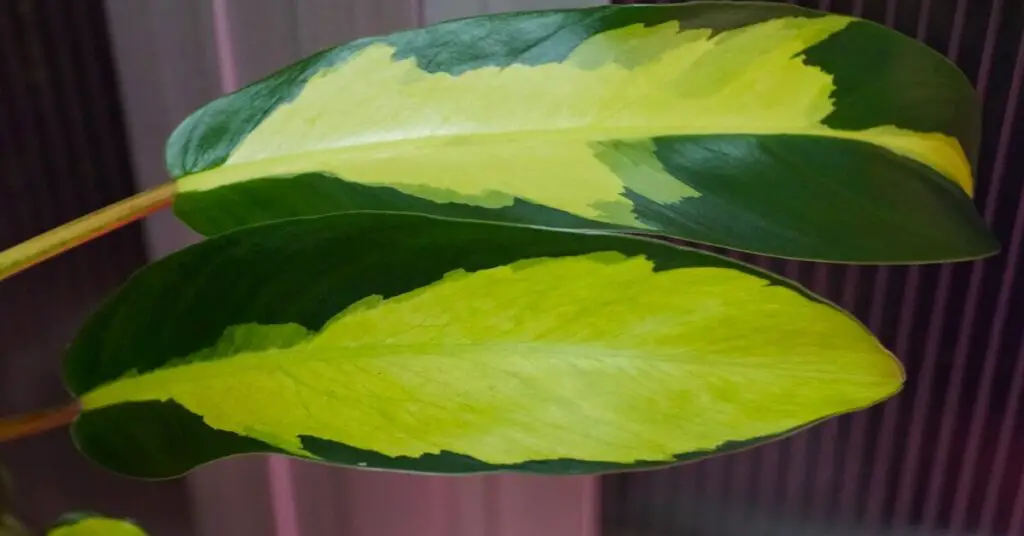With over 489 accepted species in the genus Philodendron, the Philo Thai Sunrise is among some of the rarer cultivars in this grouping.
What makes them rare is their variegated and elongated bright lime and light green leaves. Which are often covered with dark green patterned shading at the edges.
Whether they originated in Thailand or actually resemble a tropical Thai sunrise is still up for debate. However, undebatable is the Thai Sunrise Philodendron’s preference for tropical humidities and warm to moderate temperatures.
The Thai Sunrise may occasionally lose their variegation when exposed to extreme temperatures or low light. Causing them to be easily confused with relatives such as the Philo Golden Goddess. However, their pale orange stems and variegated leaves help distinguish them from similar cultivars.
Philodendron Thai Sunrise Care
These climbing plants are easy to care for, and will climb if given support such as a moss pole. When grown indoors, they tend to be more compact. And can reach a maximum size of 3 feet (1 m.) tall and 1 foot wide (0.3 m).
They are also generally not too fussy, making them perfect indoor starter houseplants for the beginner or enthusiast.
Soil
Like other Philodendrons, these plants grow best in a well-draining potting soil mix. Perlite, orchid bark, posting compose, and pumice may be added to the soil in 25% ratios each for optimal drainage.
Watering
Check the plants once a week and water only when the top 1-2 inches of the soil is dry to the touch. In winter, you can reduce watering to once every two weeks. The Thai Sunrise is somewhat drought-tolerant, so avoid overwatering, as soggy soil will lead to root rot.
Lighting
These plants thrive in medium to bright filtered sunlight. Place them next to a west- or east-facing window. Or a few feet away from a south-facing window for best lighting. These plants grow best in mid-level canopy in the wild, so avoid direct sunlight.
Humidity & Temperature
Native to the tropics, Philodendron Thai Sunrise plants require relatively higher humidities (50% or more is ideal).
Ideal temperatures fall in the range 60-75ºF (16-24ºC), plus or minus a few degrees. They can tolerate temperatures close to 50ºF (10ºC) but not for too long. So, it’s best to avoid extreme temperatures on both ends. If you live in USDA hardiness zones 9-11, these plants can be grown indoors or outdoors.
Fertilizing
For optimal growth, fertilize once a month during spring and summer with a balanced and diluted liquid fertilizer. In the winter, reduce fertilization to once every other month.
Propagation
Propagation can be done via stem cuttings with at least one node and two leaves. You can transplant the stem cuttings directly into moist soil. Or grow roots (after 3-4 weeks) in a jar of sterilized water before transplanting.
Diseases & Pests
Philo Thai Sunrises can fall victim to sap-sucking pests. Like spider mites, aphids, and scales, especially when stressed or weakened. Treat with insecticides or regular dishwashing soap and water solution.
Like other Philodendrons, the Thai Sunrise may also fall victim to fungi or bacterial infections. Which cause leaves to turn yellow or brown. Overwatering is also a common problem, and can cause root rot and powdery mildew.
Toxicity
Like other Philodendrons, the Thai Sunrise contains calcium oxalate. Which is toxic to both humans and pets if ingested. Symptoms include blisters in the mouth, burning sensations in the eyes and mouth, nausea, vomiting, and swelling. Seek immediate medical care if accidentally ingested or chewed.
Philodendron Thai Sunrise Reverted
Thai Sunrises have stable variegations, but extreme temperatures and low-light conditions may cause the plant to revert. Producing new lemon-lime green colored leaves.
You can avoid reversion by exposing the plant to more sunlight and cutting off the new non-variegated leaves to the last known variegated node.
Philodendron Golden Goddess vs Thai Sunrise
Both these plants may look similar, especially when young or when the Thai Sunrise has fully reverted. However, the Thai Sunrise will often be distinguishable by their variegated dark green and light green leaves. Versus the Golden Goddess’s uniformly lime-green leaves.
The stems on Thai Sunrises also tend to come in a pale orange color. Whereas the Golden Goddess’s stems are more uniformly green. The leaves on a Thai Sunrise are also a bit more elongated than the Golden Goddess’ leaves.

